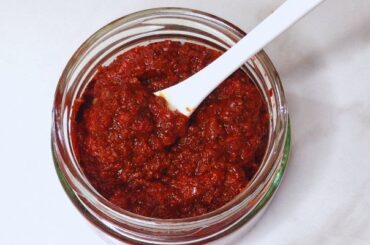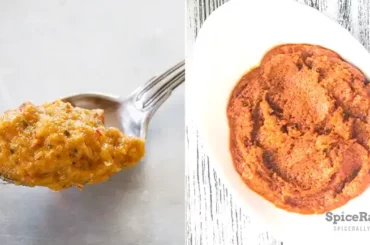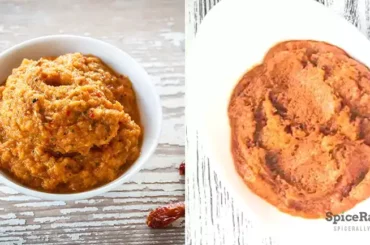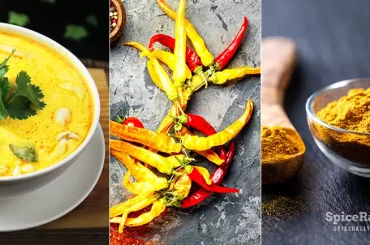Imagine having an Asian lunch with beautiful golden-hued meat or vegetable curry. And just of all that magical taste comes with one single paste! Yes- this episode is dedicated to bringing you about the most flavorful Thai yellow curry paste ingredients.
Thai yellow curry paste is considered to pack with more flavors than its cousins Thai red and green curry pasts. There’s a set of ingredients that frequently show up in this paste, including spices and herbs such as:
- Turmeric
- Curry powder
- Garlic
- Galangal
- Dried red/ yellow chilies
- Coriander seeds
- Cumin seeds
- White pepper
- Lemongrass
Some recipes may also include additional spices such as fenugreek seeds, cardamom, mace, cinnamon, and cloves. In addition to these spices and herbs, this paste often contains shrimp paste and other flavorings like salt, kaffir lime peel, and shallots.
So, without further ado, let’s get along with the rest of our article.
What Spices And Ingredients Are In Thai Yellow Curry Paste? – Explained.
Thai home cooks don’t usually buy their curry pastes from the shop as many Westerners would. In fact, they make their own, and thus Thai yellow curry paste would differ slightly in their contents.

However, as mentioned above, most of this paste’s recipes have similar ingredients. And, as the name suggests, this is one of the best curry pastes to get if you want that authentic Thai “curry” taste.
The reason is that its base flavoring is developed upon turmeric and curry powder most of the time. Occasionally, additional spices like cinnamon, fenugreek, mace, cloves, and cardamom are employed, unlike the other two cousins of this paste- the green and red curry pastes.
So, how do these flavorings give life to this mix? Let’s check out now!
Spices
01- Turmeric
Turmeric in the yellow curry paste is considered one of the two base flavorings, and this spice is responsible for most of its color. This spice is highly aromatic and earthy.
And, it undoubtedly gives a yellowish-golden hue with somewhat musky, earthy, and a bitter flavor with a slight peppery hint. Turmeric is a very suitable spice for many curries, soups, and stews.
Moreover, it pairs well with most other ingredients used in the paste, including curry powder, cumin, coriander, and galangal.
02- Curry Powder
Curry powder is used in many recipes to give this paste its color and an extra “curry” punch. This spice powder usually comes together with ingredients such as:
- Fenugreek seeds
- Turmeric
- Black pepper
- Chili powder
- Onion powder
- Cinnamon
- Nutmeg
- Cloves
- Cardamom
The content of this powder could vary depending on the curry powder you use. However, this ingredient adds a depth of flavor to the yellow curry paste. And therefore, it could especially complement many meat, fish and vegetable curries, and stews.
03- Garlic
Garlic is a staple spice that you can find in many curry pastes. Thus, it also becomes one of the main Thai yellow curry paste ingredients. The pungent, powerful flavor and intense aroma of this spice give a unique essence to this paste.
Garlic pairs really well with galangal. In addition, this spice also gets along with other spices and herbs and undeniably complements any curry, marinade, stir-fry, soup, and hearty stews.
04- Galangal
Traditionally, galangal is a staple in this curry paste. And, we see that almost all the yellow curry paste recipes use this spice whenever possible. However, galangal shows a very close resemblance to ginger.
Therefore, some recipes also use ginger in place of galangal. This spice holds an intense citrusy and pine-like flavor and gives a different taste tweak to the paste.
It often makes good teams with garlic, chilies, shallots, cumin, and coriander and helps to add a rich flavor to many curries and soups.
05- Dried Red/ Yellow Chilies
Even though Thai red and green curry pastes use chilies as their base flavor, chilies are a secondary flavoring to the yellow curry paste. The reason is that this paste focuses on its warmth and color more than the spiciness.
Many pre-packaged ones you buy from the store include dried Thai red chilies, while we found some homemade and commercially made ones containing dried Thai yellow chilies.
The level of hotness could vary upon these chilies as yellow chilies are way too milder than the red ones. However, whatever the Thai chilies used can give a touch of hotness and a hint of fiery kick to the paste, making it more appealing when added to recipes.
06- Coriander Seeds
Floral and citrusy coriander seeds are added to the paste in its ground form. And this spice is often paired with ground cumin. Coriander seeds have a gentle flavor profile that has the ability to neutralize the strong taste of this paste.
This could also complement stir-fries, marinades, stews, and curries particularly. This flavoring effectively balances the robust flavors of the yellow curry paste by overpowering the dishes bringing them down to a pleasant taste.
07- Cumin Seeds
Nutty, aromatic, and slightly sweet cumin seeds are paired well with coriander seeds in this paste. Like coriander, it is also occupied as a ground spice along with other ingredients.
The usage of ground cumin in this curry paste emphasizes the warmth apart from giving it a great flavor. And, when you make meat, fish, and seafood curries, stir-fries, or stews with this paste, cumin can essentially fulfill their overall tastes.
08- White Pepper
Apparently, white pepper is the main ingredient that could give a distinctive peppery touch to this paste. Most of the recipes use this version of pepper, while some recipes also use black pepper instead.
Even though white pepper is milder than black pepper, it carries a slightly fermented, musty, and grassy-peppery flavor. Peppercorns are often pounded with other ingredients, or simply white pepper powder is used in the mix.
White pepper is versatile enough to get along with most of the ingredients in the paste, and it complements any dish, including curries, marinades, rice dishes, soups, and stews.
Herbs Used In The Thai Yellow Curry Paste
Unlike the other two famous Red and green curry pastes, we don’t see more than one herb used in this paste. And above all, in this curry paste, they don’t use coriander root-surprising, isn’t it!
01- Lemongrass
The inner stem, or the white part of the lemongrass, is considered the most flavorful and fragrant part. Therefore, it is the part that has been employed in this paste.
In fact, lemongrass gives a strong lemon-citrusy and mint-like flavor effect, pairing it well with galangal, turmeric, shallots, etc. Coconut milk-based curries or stews are mostly complemented with the lemongrass flavor.
The dish that changed my life was tom yum kum. You start with a pot of water, add lemongrass, lime leaves, lime juice, coriander, mushrooms, and shrimp; ten minutes later, you have the most incredible, intense soup.
Jean-Georges Vongerichten
What Are The Other Thai Yellow Curry Paste Ingredients?
This paste includes other flavor elements that provide its distinctive taste apart from the spices and herbs we discussed on top. They are:
- Salt
- Shrimp paste
- Shallots
- Kaffir lime peel
- Lime juice (in some recipes)
Is Thai Yellow Curry Paste Spicy?
Since it is a “curry” paste, many of you might have this problem. Well, we should say that the Thai yellow curry paste is mildly hot.
Especially when compared to the spiciness of Thai red and green curry pastes, our subject leader is milder than them. As this paste contains some amount of chilies, you will sense a bit of spiciness, but it is rather warm than hot.
However, if you make the yellow curry paste at home, the spiciness is always adjustable. You can increase the amount of chilies and make it hotter or decrease/omit the chilies and leave it for its warmth.
Wrapping Up With The Thai Yellow Curry Paste Ingredients and Spices…
So, as you see, The Thai yellow curry paste ingredients are jam-packed with aroma and flavor to give the best experience to you when making Asian dishes.
Spices and herbs like turmeric, curry powder, white pepper, chilies, coriander seeds, cumin, seeds, galangal, ginger, and lemongrass play a significant role in giving the perfect punch to this paste.
Moreover, they are perfectly matched with the rest of the ingredients to be used in a medley of recipes that will make your dinner table a real celebration!
Related Topics
- What Ingredients Are In Thai Red Curry Paste: The Indigenous Crimson Flavor Additive
- Thai Green Curry Paste And Its Ingredients- Things Are About To Get Greener!
- 11 Smart Ways To Use Thai Red Curry Paste For A Real Taste Tweak!
- 11 Brilliant Ways To Use Thai Green Curry Paste (Apart From The Basic Curry Making)




